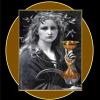 Submitted by Nwyvre on
Submitted by Nwyvre on

Although it's now socially acceptable to be a witch, that wasn't always the case, particularly here in New England. Many people today identify as witches, which usually means they are interested in the occult, folk magic, and possibly paganism. These are all good things, and most modern witches are lovely people who just want to be left alone with their candles and dried herbs.
In the past, though, no one wanted to be called a witch. The activities we associate with modern witches today - fortune telling, herbal magic, protection magic - were widely practiced across New England, sometimes by specialists called cunning folk, conjurers or seers, but more often just by average people. Curious to know if you were going to marry the boy next door? Grandma would break out the Bible, bind a key inside it, and start asking questions. Troubled by bad dreams? The farmer next door would tell you to place a knife under the bed. Everyone knew a charm or two, but no one called themself a witch.
This is because people believed witches used magic for evil: ruining crops, killing farm animals, making children sick, and causing death. Sometimes witches were motivated by jealousy, sometimes revenge, and sometimes they were working for the Devil himself. No one wanted to be a witch. Calling yourself a witch in the past would be like saying, "Hi! I'm a serial killer" today.
A community might accuse its most unpopular members of being witches, but these accusations were always false and motivated by the need to blame someone for life's misfortunes. Crops failed? Blame the mean old widow down the road and call her a witch. Child sick? Blame the crotchety guy who swears at everyone - he must be a witch.
These people weren't really witches, but there was plenty of magic for protecting one's home and family from the imaginary threat. A horseshoe placed above the front door was the most popular method, but there were others, including this one I found in Clifton Johnson's What They Say in New England (1896):
It is well to have a piece of a branch cut from a mountain ash in the house. It is as good to keep to witches as a horseshoe nailed over the door.
The practice seems to have been relatively widespread. John McNab Currier was a physician and folklorist who lived in New Hampshire in the 19th century. Currier knew a woman who blamed witches for all the misfortunes in her life and wore a necklace of mountain ash beads to deflect their evil influence:
They were cut about three eighths of an inch in length, the bark being left on, and strung on string running through the pith. She was careful to keep them concealed, but sometimes they would work up above her collar and be conspicuous. This species of tree was once quite popular among New England witch-believers as a charm against witches... (“Contributions to New England Folk-Lore,” The Journal of American Folklore, Vol. 4, No. 14 (Jul – Sep. 1891)
Folklorist Fanny Bergen also notes that many people carried pieces of mountain ash wood in their pockets and the tree was sometimes called the "witch-wood" tree (“Some Bits of Plant-Lore”, The Journal of American Folklore, Vol 5, No. 16 (Jan – Mar, 1892).
Although many folks still hang lucky horseshoes over their doorways, I haven't encountered anyone who carries around pieces of mountain ash, let alone wears a necklace made of it. Partly it's because we don't practice as much folk magic as our ancestors did, and even when we do the meaning has changed. People who hang horseshoes today usually do so to bring luck, not to keep out witches. We just aren't as afraid of witches as we once were, which is a good thing.
I also think New Englanders, and Americans in general, are less familiar with trees and plants than we were were a century ago. Very few of us work in agriculture or even outdoors, so we don't need to be well-acquainted with what's growing around us. Industrial and scientific progress has made us less superstitious (and less likely to hang our neighbors as witches), but it's also disconnected us from our immediate environment.
Even if I wanted to make a mountain ash necklace, I probably couldn't identify the tree. They tend to grow in higher elevations, and I've lived most of my life in the coastal regions. The mountain ash (sorbus americana) is a small tree that bears orangey red berries. Sorbus Americana is very similar to the European rowan tree, which has a lot of magical lore attached to it, and I assume that's why magical powers are ascribed to the mountain ash.
Peter Muise
http://newenglandfolklore.blogspot.com/2021/04/mountain-ash-or-witch-wood-tree.html